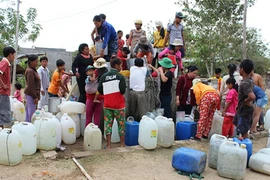Hanoi (VNA) - Although the dry season has started, many areas in south-eastern region have faced with prolong drought which would affect the lives of local farmers.
Due to El Nino, the rainy season in southern Binh Phuoc province came late and finished early than usual. The water level at the province's reservoirs was lowered than average by between 1.5 and 3m as a result of low level of rain.
Hot weather and drought are expected to hit the province in the 2015-2016 dry season, with the highest temperature may reach 41 degree Celsius, according to forecasts from Binh Phuoc Hydro-meteorology Centre.
Many areas of HCM City and Tay Ninh province were at risk of lacking water for agricultural production as a result of low water storage at Dau Tieng Reservoir. The water level at the reservoir was measured at 22.4m last month, a reduction of 2.15m compared with the same period last year.
Nguyen Van Tram, Chairman of Binh Phuoc Province's People' Committee, said the provincial agriculture department has instructed localities and irrigation management units to take measures to deal with drought in 2015-2016 dry season.
Le Hoang Quan, Chairman of HCM City People's Committee has recently ordered relevant agencies to concentrate on water storage and take preparation for anti-drought activities.
Authorities of southern provinces of Dong Nai, Binh Duong and Tay Ninh have also issued measures to cope with persistent drought in the dry season as well as called on farmers to change to crops that require less water.
Some localities in south central coast region had to stop 2015-2016 winter-spring crops due to serious water shortage. Phu Yen province was expected to cease cultivation 170ha of rice and Ninh Thuan province was expected to stop growing 5,800ha of rice and other crops. Khanh Hoa province planned to switch from more than 4,200ha of rice crops to other crops.-VNA





























